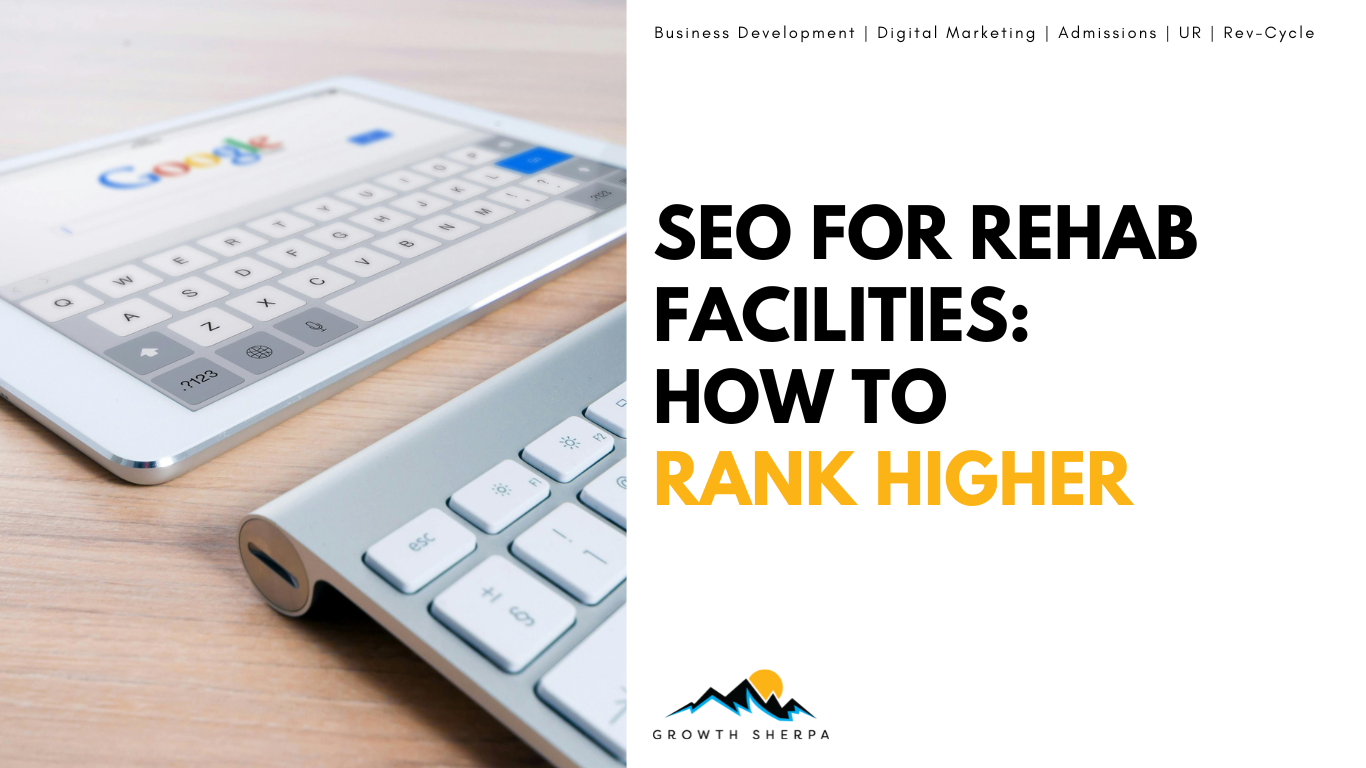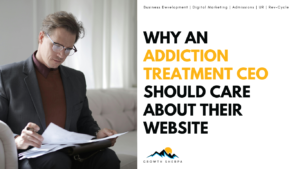In today’s digital landscape, addiction treatment centers are no longer just competing with local providers — they’re up against rehab facilities nationwide. With more people searching for help online, ranking at the top of search engine results pages (SERPs) has become crucial for any facility looking to attract clients. If your rehab facility isn’t visible when someone searches for addiction treatment services, you risk missing out on critical opportunities to help those in need. That’s where search engine optimization (SEO) comes into play.
SEO is a powerful tool that allows your rehab facility to increase its visibility and attract more potential clients by improving how well your website ranks on search engines like Google. But getting to that coveted first page doesn’t happen by accident. In this post, we’ll break down the essential strategies for boosting your rehab facility’s SEO, from keyword optimization to content creation, so you can start ranking higher and bringing in more patients.
Why SEO is Essential for Addiction Treatment Centers
Before diving into SEO tactics, it’s important to understand why SEO is such a game-changer for rehab facilities. Most people looking for addiction treatment begin their search online, typing in keywords like “drug rehab near me” or “best addiction treatment center.” When your facility ranks at the top of these searches, you’re more likely to receive inquiries, fill beds, and ultimately help more people.
SEO offers a sustainable way to grow your online presence. Unlike paid ads that stop delivering results once your budget runs out, SEO efforts compound over time. The higher your site ranks, the more authority you gain in Google’s eyes, and the easier it becomes to maintain and improve those rankings. The result? Long-term, cost-effective lead generation.
Key SEO Strategies to Boost Your Rankings
- Keyword Research: Know What Your Patients Are Searching For
Effective SEO starts with understanding the language your potential clients are using to find addiction treatment services. Keyword research is the foundation of any SEO strategy. You’ll need to identify the high-intent keywords that people are typing into search engines when they’re looking for help. These keywords are often related to location (“rehab in [city]”), specific services (“inpatient addiction treatment”), and conditions (“alcohol addiction treatment”).
Tools like Google Keyword Planner, SEMrush, and Moz can help you discover high-volume, relevant keywords. Once you’ve identified these terms, you can strategically incorporate them into your website’s content, metadata, and blogs to improve your chances of ranking.
Some high-performing keywords for addiction treatment might include:
- “Drug rehab center near me”
- “Best addiction treatment programs”
- “Mental health and substance abuse treatment”
- “Inpatient rehab for alcohol addiction”
Incorporating these keywords naturally into your content helps Google recognize your website as relevant to those searching for addiction treatment.
- On-Page Optimization: Structuring Your Website for Success
On-page SEO refers to optimizing the elements on your website to improve its ranking. These elements include title tags, meta descriptions, header tags, image alt text, and internal linking. Each of these components signals to search engines what your page is about and why it’s relevant to search queries.
Title tags and meta descriptions are critical because they appear directly in search engine results. Your title tag should include your target keywords and accurately describe the content of your page. For example, “Inpatient Drug Rehab Center in [City] | [Facility Name]” is clear, keyword-rich, and appealing to both users and search engines.
Header tags (H1, H2, H3) are important for structuring your content. Search engines give more weight to text inside header tags, so make sure your headers are descriptive and include relevant keywords.
Internal linking is another essential aspect of on-page SEO. By linking to other pages on your site (like blog posts, service pages, or contact pages), you help both users and search engines navigate your content. This not only improves user experience but also distributes SEO value across your site.
- Content Creation: Provide Value to Your Audience
Content is the cornerstone of SEO. Google rewards websites that offer valuable, high-quality content relevant to what users are searching for. Regularly publishing content that answers common questions or addresses concerns about addiction treatment can help you rank higher and attract more traffic.
Your content strategy should focus on creating blog posts, guides, and articles that target long-tail keywords — longer, more specific search phrases like “how to find the best rehab facility for alcohol addiction” or “what to expect during inpatient drug treatment.” These keywords are less competitive but often attract more qualified traffic.
Some content ideas for rehab facilities include:
- Blog posts about different types of treatment options (inpatient vs. outpatient)
- Guides on the signs of addiction and how to seek help
- Personal stories of recovery from addiction
- Articles on what to expect from various therapies offered at your facility
Not only does creating valuable content improve SEO, but it also positions your facility as an expert in addiction treatment, building trust with potential clients.
- Local SEO: Attract Clients in Your Area
For rehab facilities, local SEO is particularly important because many people search for treatment options in their local area. Optimizing for local SEO means ensuring that your facility shows up when people search for services near them, such as “drug rehab near me.”
To improve your local SEO:
- Claim and optimize your Google Business Profile (formerly Google My Business). Make sure your business name, address, and phone number are accurate and consistent across all listings.
- Encourage satisfied clients and their families to leave positive Google reviews. Reviews play a significant role in local rankings.
- Optimize your website for location-based keywords, like “[City] addiction treatment” or “rehab center in [State].”
- Technical SEO: Ensure Your Site is Fast and Mobile-Friendly
Technical SEO refers to optimizing the backend of your website to make sure it’s fast, secure, and easy for search engines to crawl. Google prioritizes sites that offer a seamless user experience, especially on mobile devices.
Some key areas of focus for technical SEO include:
- Page speed: A slow-loading website can hurt your rankings and frustrate potential clients. Use tools like Google PageSpeed Insights to identify ways to speed up your site.
- Mobile optimization: More than half of all web traffic comes from mobile devices, and Google now uses mobile-first indexing, meaning it primarily evaluates the mobile version of your site for rankings. Ensure your site is fully responsive and offers a great user experience on smartphones and tablets.
- SSL certificate: An SSL certificate ensures that your website is secure (with HTTPS in the URL), which is essential for both rankings and user trust.
Case Study: How a Rehab Facility Transformed Its SEO
A small rehab facility in the Midwest was struggling to attract clients. Despite offering excellent treatment programs, their website traffic was low, and their facility wasn’t showing up in local searches. After implementing an SEO strategy that focused on keyword optimization, content creation, and local SEO improvements, they saw significant changes.
By updating their site’s metadata with location-based keywords, creating blog posts addressing common patient questions, and optimizing their Google Business Profile, they increased their website traffic by 40% in six months. More importantly, they saw a 25% increase in patient inquiries, helping them fill more beds and provide care to more individuals.
In the addiction treatment industry, SEO is a critical tool for attracting new clients and staying competitive. By optimizing your website for search engines through strategic keyword usage, on-page optimization, valuable content creation, and local SEO efforts, your rehab facility can rank higher and become more visible to those seeking help.
With the right SEO strategy, your facility can not only grow its online presence but also reach more people in need of addiction treatment. SEO isn’t a quick fix — it’s a long-term investment in the future success of your facility. But the rewards are worth it: more visibility, more patients, and more lives changed for the better.




